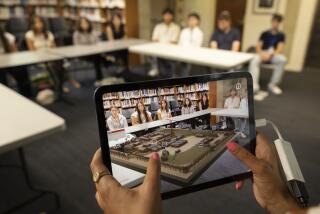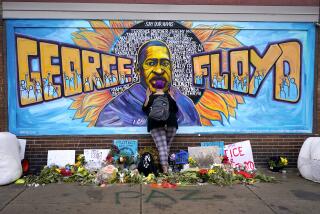Riots Provide a Real-Life Exhibit Probing Attitudes on Racism
- Share via
Long before Los Angeles erupted in violence, Gerald Margolis and his colleagues at the Simon Wiesenthal Center had decided to put social justice at the heart of their new museum.
The idea sounded exciting--to create a central interactive exhibit that prompted visitors to explore their own attitudes about racism and responsible citizenship. But after months of work on a computerized “tolerance test” that asked visitors to react to hypothetical situations, Margolis recalls being frustrated by the results.
“We were merely creating fictional scenarios--like asking people how they’d feel if they were assigned a roommate who was a different race,” said the director of the center’s new Museum of Tolerance. “I didn’t feel it did enough to bring in real issues.”
Last spring, when the four police officers accused of beating motorist Rodney G. King were found not guilty, the museum’s designers were still struggling to make the exhibit work. But as Los Angeles caught fire, they realized that their project had been overtaken by real events.
“There was no question what we had to do,” Margolis said. “We had our work cut out.”
So, with the museum’s opening deadline looming ever closer, they started over. The intriguing result, displayed on six television monitors dotted throughout the museum’s section on tolerance, is a videotaped timeline that begins on the night King was beaten, continues through the riots and concludes with efforts to rebuild the city.
With the touch of a button, visitors can move forward or backward in time, choosing from a topical menu that includes segments on the media’s role in the rioting, on acts of courage, and on the causes and costs of the unrest. Visitors can also solicit the views of residents and community leaders, drawing on filmed interviews with an African-American police officer, a Latino gang member, a Korean-American store owner and an Anglo fireman, among others.
Finally, the computer interviews the museum visitors. First they are asked to provide a brief autobiographical sketch--age, gender, ethnicity. Then, they are queried: Would the not guilty verdicts have been different if African-Americans had been on the jury? How common do you think racist attitudes are among police officers in your community?
The exhibit keeps a running tally of how visitors answer. So after you’ve admitted whether looting looked like fun to you (a lot? a little? not at all?), you can compare your response to everyone else’s. After revealing how safe you feel in your neighborhood, you can study how your views differ from views expressed by people of other ethnic groups.
Special care was taken to achieve a balanced tone, Margolis said--the text and the polling questions were rewritten several times to avoid steering visitors toward particular answers or points of view. Regarding citizens who took up arms during the riots, visitors are asked: “Were they justified in arming themselves? Or did they add fuel to the fire?” And after the narrator says that live television may have helped the riots to spread, he adds: “Most Angelenos . . . would have felt even more powerless if the media hadn’t been there to cover the story.”
“You’re getting a little bit of a seesaw,” Margolis said. But that was essential to achieve the museum’s fundamental goal: getting people thinking without telling them what to think.
“A good museum has a bit of an argument with the society it finds itself in,” he said. “But you never want to say: ‘This is good medicine for you.’ Because people will inevitably say, ‘Don’t tell me what’s good medicine for me. You ain’t my momma.’ ”
More to Read
The biggest entertainment stories
Get our big stories about Hollywood, film, television, music, arts, culture and more right in your inbox as soon as they publish.
You may occasionally receive promotional content from the Los Angeles Times.










